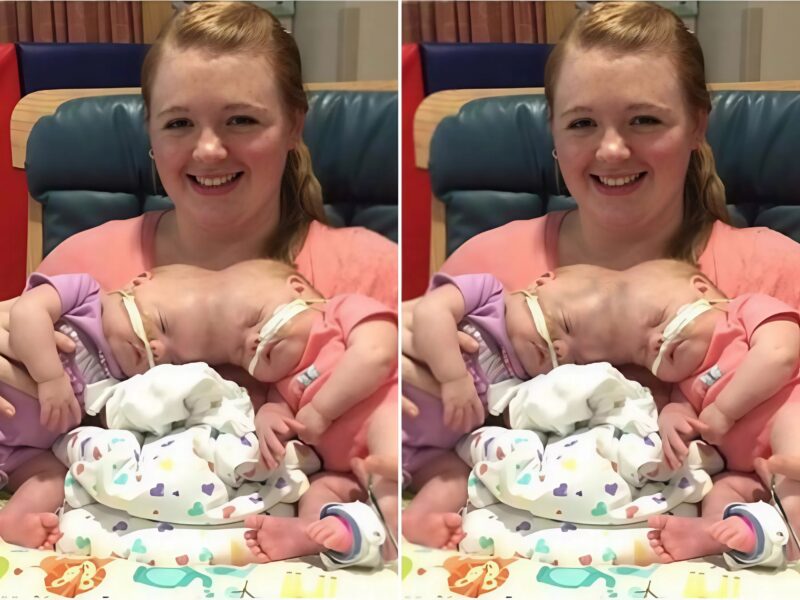When Amelia and Sophia were born, the delivery room fell silent. The doctors, who had prepared for complications, could hardly mask their shock. The girls were conjoined at the head, their tiny bodies fused in a way that defied the natural order. For their parents, Elena and David, joy and fear arrived together that morning.
“It’s a miracle,” Elena whispered through her tears, holding her daughters as closely as she could. But behind her words hovered the question everyone was too afraid to ask: Would they survive?
From their earliest days, Amelia and Sophia displayed a synchronicity that fascinated those around them. If Amelia giggled, Sophia’s mouth would curve into the same grin seconds later. When Sophia cried, Amelia’s eyes filled with tears too, as though their emotions were tethered by invisible strings. Nurses would often pause in wonder. “It’s like they can hear each other’s thoughts,” one said.
At home, life was full of adjustments. Simple tasks like bathing or dressing them required choreography between parents, grandparents, and nurses. Yet Elena and David refused to treat their daughters as fragile. They encouraged them to play, to discover, to be children despite the extraordinary circumstances.
But the truth loomed. Doctors warned that as the girls grew, their fused skulls could cause severe complications—limited mobility, developmental delays, and potentially life-threatening pressure on their brains.
The word “separation” surfaced again and again. Each time, it filled Elena and David with dread. The risks were enormous. Success could mean two independent lives. Failure could mean losing them both.
Still, as Amelia and Sophia grew, their individuality began to peek through their mirrored gestures. Amelia loved music—she hummed tunelessly to herself, drumming her fingers on whatever she could find. Sophia adored books, her small hands clutching pages as though she wanted to read the world. Their parents realized: these were not one child living in two bodies. They were two souls yearning for their own futures.
And so, the decision was made.
The surgery was scheduled when the girls were just over three years old. For months beforehand, their parents met with surgeons, neurologists, and specialists from across the globe. Models of their fused skull were printed in 3D. Teams rehearsed for hours in simulation labs, practicing every cut, every stitch, every emergency that might arise.
The night before the operation, Elena sat by their crib, unable to sleep. She stroked Amelia’s hair with one hand and Sophia’s with the other. “No matter what happens, you will always be together,” she whispered. Tears slid down her cheeks, but in her heart, she clung to hope.
On the morning of the surgery, the girls were wheeled into the operating theater. The room was filled with more than thirty doctors and nurses, each assigned a role as precise as clockwork. As the anesthesia took hold, Amelia clutched Sophia’s hand, and Sophia squeezed back.
The operation lasted more than twelve hours. Outside, Elena and David prayed, pacing endless circles in the waiting room. Every update—“They’re stable,” “We’re making progress”—was met with both relief and terror.
Finally, a surgeon emerged, his mask pulled down, fatigue etched across his face. “They are separated,” he said. “Both girls are alive.”
Elena collapsed into David’s arms, sobbing with gratitude.
Recovery was slow, filled with setbacks and triumphs. Amelia struggled with balance, her body learning how to walk without Sophia’s weight beside her. Sophia endured painful therapies to strengthen her neck and back. Yet day after day, their resilience astonished everyone.
What amazed doctors most was that despite their newfound independence, the girls retained an uncanny bond. In separate hospital rooms, their heart rates sometimes rose or fell in unison. When Amelia laughed, Sophia, even without seeing her, often smiled moments later. Nurses shook their heads in disbelief. “It’s like a piece of them is still connected, somewhere we can’t see.”
Years passed. The girls grew into vibrant, distinct individuals. Amelia, true to her passion, began piano lessons at seven. Her fingers flew across keys with a natural rhythm that stunned her teachers. Sophia devoured books, filling journals with stories of imaginary worlds.
But their bond remained undeniable. At school, if Sophia faltered during a test, Amelia would glance up from her own desk, as though sensing it. If Amelia tripped in the playground, Sophia’s hands would twitch in response. Their teachers often said, “It’s as if they share a secret language.”
The media occasionally revisited their story, marveling at the triumph of modern medicine. But for Elena and David, the real miracle was quieter: two daughters who fought through impossible odds, not just surviving but thriving.
One evening, when the girls were ten, Elena overheard them talking before bed. “Do you remember when we were together?” Amelia asked softly.
“Yes,” Sophia replied. “I don’t remember everything, but I remember the warmth.”
Amelia smiled. “Me too. Even though we’re separate now, I still feel you.”
Sophia reached out, and their hands met across the gap between their beds.
Today, as teenagers, Amelia and Sophia continue to amaze. They have different friends, different hobbies, different dreams—yet their bond remains unbreakable. Their story has become a symbol of resilience, love, and the strength of family.
Doctors had once described their future as “difficult,” their survival as “uncertain.” But Amelia and Sophia proved them wrong. Through determination, science, and an unshakable connection, the impossible had been made possible.
And though they now walk separate paths, their hearts remain forever intertwined—an invisible thread tying them to the miracle that began when they were one.
